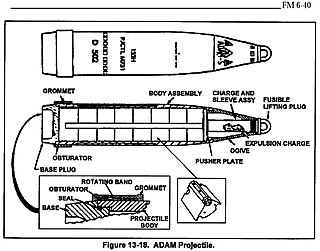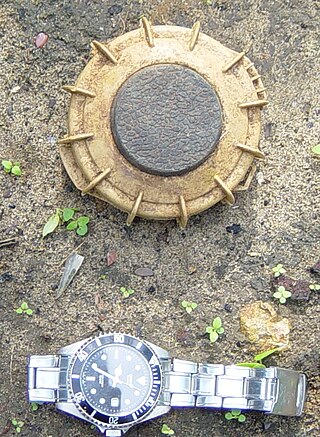
A land mine, or landmine, is an explosive weapon concealed under or camouflaged on the ground, and designed to destroy or disable enemy targets, ranging from combatants to vehicles and tanks, as they pass over or near it.

The Claymore mine is a directional anti-personnel mine developed for the United States Armed Forces. Its inventor, Norman MacLeod, named the mine after a large medieval Scottish sword. Unlike a conventional land mine, the Claymore may be command-detonated, and is directional, shooting a wide pattern of metal balls into a kill zone. The Claymore can also be activated by a booby-trap tripwire firing system for use in area denial operations.
The GATOR mine system is a United States military system of air-dropped anti-tank and anti-personnel mines developed in the 1980s to be compatible with existing cluster dispensers. It is used with two dispenser systems—the Navy 230 kg (500 lb) CBU-78/B and the Air Force 450 kg (1,000 lb) CBU-89/B. Additionally the mines are used with the land- and helicopter-based Volcano mine system.

The International Campaign to Ban Landmines (ICBL) is a coalition of non-governmental organizations whose stated objective is a world free of anti-personnel mines and cluster munitions, where mine and cluster munitions survivors see their rights respected and can lead fulfilling lives.

An unmanned ground vehicle (UGV) is a vehicle that operates while in contact with the ground without an onboard human presence. UGVs can be used for many applications where it is inconvenient, dangerous, expensive, or impossible to use an onboard human operator. Typically, the vehicle has sensors to observe the environment, and autonomously controls its behavior or uses a remote human operator to control the vehicle via teleoperation.

The M16 mine is a United States-made bounding anti-personnel mine. It was based on captured plans of the World War II era German S-mine and has similar performance. The mine consists of a cast iron body in a thin steel sleeve. A central fuze well on the top of the mine is normally fitted with a pronged M605 pressure/tension (tripwire) fuze. Sufficient pressure on the prongs or tension on an attached tripwire causes the release of a striker. The freed striker is forced into a percussion cap which ignites a short pyrotechnic delay. The purpose of this delay is to allow the victim to move off the top of the mine, to prevent its upward movement from being blocked. Once the delay has burned through, a 4.5-gram black powder charge is ignited, which launches the inner iron body of the mine up into the air. The charge also ignites a second pair of pyrotechnic delays.

Area denial artillery munition (ADAM) is a family of United States land mines and 155 mm artillery projectiles.

An anti-personnel mine or anti-personnel landmine (APL) is a form of mine designed for use against humans, as opposed to an anti-tank mine, which target vehicles. APLs are classified into: blast mines and fragmentation mines; the latter may or may not be a bounding mine.
The M93 Hornet mine was an American anti-tank mine. It was a wide-area mine, capable of attacking targets up to 100 meters away from its position.
ARGES, ACEATM or MACPED is an anti-tank off-route mine, developed by an international consortium to meet the needs of the British, French and German armed forces. The system consists of a rocket and launch tube, a tripod and a sensor package.

An anti-handling device is an attachment to or an integral part of a landmine or other munition such as some fuze types found in general-purpose air-dropped bombs, cluster bombs and sea mines. It is designed to prevent tampering or disabling, or to target bomb disposal personnel. When the protected device is disturbed, it detonates, killing or injuring anyone within the blast area. There is a strong functional overlap of booby traps and anti-handling devices.
In military munitions, a fuze is the part of the device that initiates its function. In some applications, such as torpedoes, a fuze may be identified by function as the exploder. The relative complexity of even the earliest fuze designs can be seen in cutaway diagrams.

The IAI Harop is a loitering munition developed by the MBT division of Israel Aerospace Industries. Loitering munitions are designed to loiter above the battlefield and attack targets by crashing into them and exploding.
The Modular Advanced Armed Robotic System (MAARS) is a robot that is being developed by Qinetiq. A member of the TALON family, it will be the successor to the armed SWORDS robot. It has a different, larger chassis than the SWORDS robot, so has little physically in common with the SWORDS and TALON

The AeroVironment Switchblade is a miniature loitering munition designed by AeroVironment and used by several branches of the United States military. Small enough to fit in a backpack, the Switchblade launches from a tube, flies to the target area, and crashes into its target while detonating its explosive warhead. The name Switchblade comes from how the spring-loaded wings are folded inside a tube and flipped out once released.
Family of Scatterable Mines (FASCAM) is an umbrella term for a range of systems of the armed forces of the United States, which allows a maneuver commander to rapidly place mines as a situational obstacle; as a reserve obstacle emplacement capability; and to directly attack enemy formations through disrupt, fix, turn, and block. Modern fusing, sensing, and anti-disturbance devices allow scatterable mines to defeat enemy attempts to reduce and/or clear the minefield. FASCAM mines are delivered through artillery, rocket launchers, indirect crew served weapons, special mine sowing vehicles, helicopters and aircraft. FASCAM mines utilize a random or pre-programmed self-destruct period, countermeasure hardening and anti-disturbance features. All FASCAM mines have an active life cycle and self-destruct (SD) time after their active life has expired. The duration of the active life varies from 4 hours to 15 days depending on the system.

A loitering munition, also known as a suicide drone, kamikaze drone, or exploding drone, is a kind of aerial weapon with a built-in warhead that is typically designed to loiter around a target area until a target is located, then attack the target by crashing into it. Loitering munitions enable faster reaction times against hidden targets that emerge for short periods without placing high-value platforms near the target area and also allow more selective targeting as the attack can be changed mid-flight or aborted.
The SCORPION(Self CORrecting Projectile for Infantry OperatioN) program was a research initiative funded by the U.S. Defense Advanced Research Projects Agency (DARPA) and led by the U.S. Army Research Laboratory (ARL) and the Georgia Institute of Technology to integrate micro adaptive flow control (MAFC) technology into small caliber munitions to develop spinning, guided projectiles. The program led to the creation of a spin-stabilized 40 mm grenade, also called SCORPION, that could propel itself to its target by using calculated micro-jet bursts of air to correct its path once launched.
The XM1100 Scorpion, formerly known as the Intelligent Munitions System, was an anti-vehicle, smart ground munition developed by Textron Defense Systems as a safer alternative to traditional landmines. The Scorpion was originally a component of the Future Combat Systems program. It was a remotely controlled, integrated system of lethal and non-lethal munitions, ground sensors, and communication technology that could autonomously detect, track, and destroy light-wheeled to heavy-tracked vehicles.

The PTM-1, also known as the PTM-1G, PTM-1S, and the PGMDM is a Soviet/Russian plastic-bodied anti-vehicle landmine. It is generally deployed by aircraft via cluster munition dispenser such as the KMGU munitions dispenser, helicopter or rocket artillery via the BM-21 or BM-27 rocket systems.












